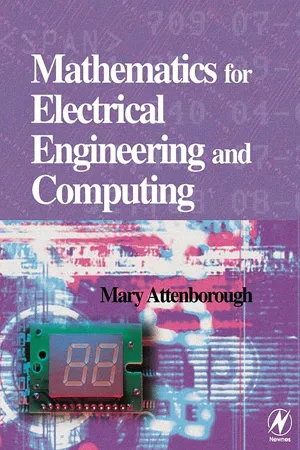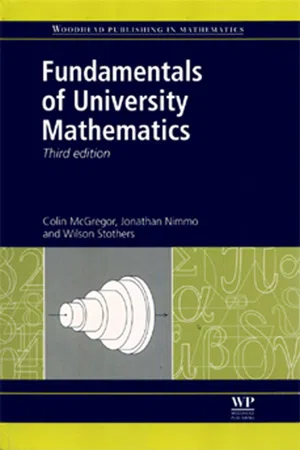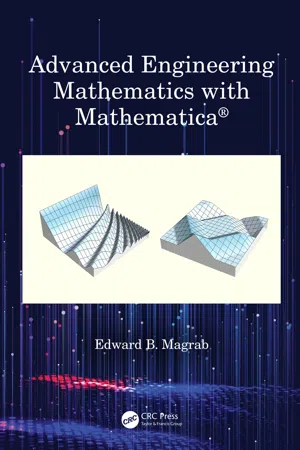Physics
Matrices in Physics
Matrices in physics are used to represent physical quantities and transformations in a concise and organized manner. They are essential in quantum mechanics, where they represent observables and operators. Matrices also play a crucial role in solving systems of linear equations and analyzing the behavior of physical systems.
Written by Perlego with AI-assistance
Related key terms
Related key terms
1 of 4
Related key terms
1 of 3
5 Key excerpts on "Matrices in Physics"
- eBook - ePub
- Fletcher Dunn, Ian Parberry(Authors)
- 2011(Publication Date)
- A K Peters/CRC Press(Publisher)
Chapter 4Introduction to Matrices
Unfortunately, no one can be told what the matrix is. You have to see it for yourself.— Morpheus in The Matrix (1999)Matrices are of fundamental importance in 3D math, where they are primarily used to describe the relationship between two coordinate spaces. They do this by defining a computation to transform vectors from one coordinate space to another.This chapter introduces the theory and application of matrices. Our discussion will follow the pattern set in Chapter 2 when we introduced vectors: mathematical definitions followed by geometric interpretations.- Section 4.1 discusses some of the basic properties and operations of matrices strictly from a mathematical perspective. (More matrix operations are discussed in Chapter 6 .)
- Section 4.2 explains how to interpret these properties and operations geometrically.
- Section 4.3 puts the use of matrices in this book in context within the larger field of linear algebra.
4.1 Mathematical Definition of Matrix
In linear algebra, a matrix is a rectangular grid of numbers arranged into rows and columns . Recalling our earlier definition of vector as a one-dimensional array of numbers, a matrix may likewise be defined as a two-dimensional array of numbers. (The “two” in “two-dimensional array” comes from the fact that there are rows and columns, and should not be confused with 2D vectors or matrices.) So a vector is an array of scalars, and a matrix is an array of vectors.This section presents matrices from a purely mathematical perspective. It is divided into eight subsections. - Mary P Attenborough(Author)
- 2003(Publication Date)
- Newnes(Publisher)
13Systems of linear equations, matrices, and determinants
13.1 Introduction
The widespread use of computers to solve engineering problems means that it is important to be able to represent problems in a form suitable for solution by a computer. Matrices are used to represent: systems of linear equations; transformations used in computer graphics or for robotic control; road, electrical and communication networks, and stresses and strains in materials. A matrix is a rectangular array of numbers of dimension m × n where m is the number of rows and n is the number of columns in the matrix. Matrices are also useful because they enable us to consider an array of numbers as a single object, represent it by a single symbol, and manipulate these symbols conveniently. In this chapter, we look at applications of matrices and arithmetic operations on matrices and some common numerical methods. We shall also look at the problem of solving systems of linear equations. The methods of solving linear systems of equations are well understood and we only need to be able to solve simple cases of such problems ‘by hand’. However, it is important to be able to express a problem in matrix form and also appreciate situations where no solution exists or where more than one solution exists. This allows to analyse the problems of ill-conditioning of systems of equations, which can lead to instability in the solution and the problem of over- or under-determinacy, where either we have too much information, leading to possibly contradictory conditions, or we have not got enough to produce a single set of solutions for the unknowns.We shall also look at the eigenvalue problem. The technique of finding eigenvalues will become particularly important when applied to systems of differential equations which we meet in Chapter 14 .13.2 Matrices
A matrix is a rectangular array of numbers. They may also be used as a simple store of information as in the following example.- eBook - ePub
- Michael Harrison, Patrick Waldron(Authors)
- 2011(Publication Date)
- Routledge(Publisher)
matrix.Definition 1.2.1 A matrix is a rectangular array of scalars called elements (or entries). In this book, scalars will generally be real numbers.Such an array is exemplified in the following general notation for a matrix.Notation 1.2.1 A general matrix A can be written asmA =[=]a 11a 12⋯a1 na 21a 22⋯a2 n⋮ ⋮ ⋮am 1a⋯m 2am n[a]i jNotice the use of a bold upper-case Roman letter for the matrix and the corresponding lower-case letter for its scalar elements. This will be our usual convention when referring to matrices and scalars. Note also the use of subscripts denoting the row and the column to which each element belongs. The number of rows and the number of columns determine the order or dimension of the matrix; here the order is m × n, signifying m rows and n columns and hence mn elements in all. Sometimes it may be useful to make the order explicit by means of a subscript: Am×n. Note further that it is often very useful to denote a matrix by means of its typical element, [aij ]. Thus an efficient way of representing a matrix is to write [aij ]m×n. When m = n, and the number of rows and columns is the same, we say that the matrix is a square matrix.A matrix for which m = 1 is a single row of n elements; this is often called a row vector. Similarly, an m × 1 matrix may be called a column vector. We shall also sometimes refer to m × 1 column vectors as m-vectors, especially from Chapter 5 onwards. Our notation for row and column vectors, respectively, is as follows.Notation 1.2.2 A general row vector r can be written asmr =[]r 1r 2⋯r nNotation 1.2.3 A general column vector c can be written asc =or (c1 ,c2 , ... ,c[]c 1c 2⋮c mm) to economize on space - eBook - ePub
- Colin McGregor, Jonathan Nimmo, Wilson Stothers(Authors)
- 2010(Publication Date)
- Woodhead Publishing(Publisher)
Chapter 11Matrices and Linear Equations
In Chapter 1 , we mentioned the fact that a pair (x, y ) of real numbers can be used to represent a point in the plane. In Chapter 6 , we used such a pair to represent a complex number. This is an example of an important aspect of mathematics— a mathematical object may be interpreted in several different ways. Once we have studied the mathematical objects, we have information which is available in every interpretation.In this chapter we introduce a new mathematical object—the matrix. An m × n matrix is a rectangular array of mn numbers. We can think of the matrix as consisting of m rows , each having n entries , or as n columns , each having m entries. For example,is a 2 × 3 matrix. We regard a matrix as a single entity, to be manipulated as a whole.We define addition on the set of m × n matrices. This operation has properties similar to the addition of real numbers. In particular, there is azero matrix Om × nin the set which behaves like 0 in , i.e.Under certain circumstances, we can define multiplication of matrices. Now some of the results are unfamiliar. For example, there are matrices A and B for which AB ≠ BA.Matrices have many uses in mathematics and its applications. Here we consider just one—the solution of (systems of) linear equations. Looking at such a system leads to the introduction of new operations on matrices. We develop a systematic method for finding all the solutions.In the final sections, we return to the mathematical study of matrices. We consider the existence of matrix inverses. Along the way, we meet the concept of the determinant of a (square) matrix. This is an important topic in its own right and will be used in Chapter 13 in connection with the vector product.11.1 Basic Definitions
Definitions 11.1.1 Let be a number system. A matrix defined over is a rectangular array of elements of . These elements are the entries of the matrix. If a matrix A has m rows (horizontal lines of entries) and n columns (vertical lines), then A is of type m × n or is an m × n bmatrix. - Edward B. Magrab(Author)
- 2020(Publication Date)
- CRC Press(Publisher)
1 Matrices, Determinants, and Systems of Equations 1.1 Definitions A matrix is a rectangular array of numbers (or symbols or expressions) consisting of m rows and n columns. Such an array is called a matrix of order (m × n) [or simply an (m × n) matrix], and is denoted as A = a 11 a 12 ⋯ a 1 n a 21 a 22 ⋯ a 2 n ⋮ a m 1 a m 2 ⋯ a m n (1.1) where the a ij are the elements of the array. The first subscript denotes the row, and the second subscript denotes the column in which the element appears. When the number of rows equals the number of columns, that is, when m = n, the matrix is called a square matrix of order n. Operations with matrices are subject to certain rules, which will be indicated as we progress. It should be realized that a matrix is not a single quantity; it is a representation of an array of entities. For a (2 × 3) matrix, Eq. (1.1) is created with Mathematica procedure M1.1. The transpose of a matrix is obtained by interchanging the rows and columns and the transpose operation is denoted with a superscript T. Thus, the transpose of the (m × n). matrix A is B = A T = a 11 a 12 ⋯ a 1 n a 21 a 22 ⋯ a 2 n ⋮ a m 1 a m 2 ⋯ a m n T = b 11 = a 11 b 12 = a 21 ⋯ b 1 m = a m 1 b 21 = a 12 b 22 = a 22 ⋯ b 2 m = a m 2 ⋮ b n 1 = a 1 n b[--=PLGO-SEPARATOR. =--]n 2 = a 2 n ⋯ b n m = a m n (1.2) where B is now an (n × m) matrix. For a (2 × 3) matrix, Eq. (1.2) is created with Mathematica procedure M1.2. A symmetric matrix is a square matrix in which a ij = a ji. Thus, for a symmetric matrix A = A T (1.3) A skew-symmetric matrix is a square matrix in which a ij = − a ji, which implies that a ii = 0. Thus, A = − A T A column matrix is a matrix with only one column, that is, an (m × 1) matrix. This matrix is denoted as a = a 11 a 21 ⋮ a m 1 = a 1 a 2 ⋮ a m (1.4) A column matrix is frequently referred to as a column vector. A row matrix is a matrix with only one row, that is, a (1 × m) matrix
Index pages curate the most relevant extracts from our library of academic textbooks. They’ve been created using an in-house natural language model (NLM), each adding context and meaning to key research topics.
Explore more topic indexes
Explore more topic indexes
1 of 6
Explore more topic indexes
1 of 4




